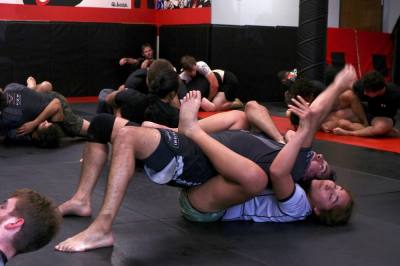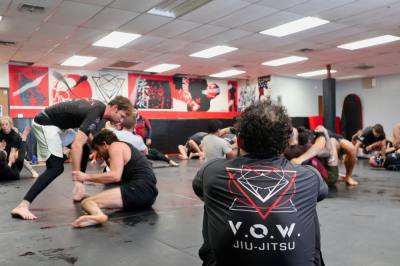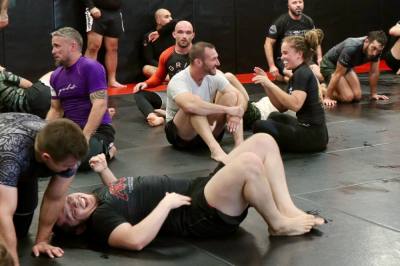This scene is a part of a growing combat sport that has all of Austin in a stronghold: Brazilian jiujitsu.
The background
Since the pandemic began, dozens of Brazilian jiujitsu and grappling sport centers—including Village of Wolves Brazilian Jiu-Jitsu—have opened across the Greater Austin area, catering to all ages and skill levels.
The martial art is a 20th century take on ancient Japanese jiujitsu—a name that means “gentle art,” according to Gracie Museum. Unlike other combat sports, jiujitsu is a full-contact grappling technique that does not involve striking. Instead, fighters remain close to the ground and attempt to lock the other in a compromising position until they submit.
How we got here
Much like the tech industry, Brazilian jiujitsu is largely an export of California, said Austin native Ryan Villalobos, who has over 15 years of experience in the local scene and is the owner of VOW BJJ.
“We are in super high contact, rolling around, so during the pandemic, it was like the worst possible thing you could do,” Villalobos said. “A lot of the California gyms shut down, and they wanted to be somewhere less restrictive for business.”
Six Blades, an international Brazilian jiujitsu franchise, moved its San Diego headquarters to Austin during the pandemic after co-founder Xande Ribeiro decided Austin was a more central location between the two coasts.
“Soon after I arrived in Austin in 2021, this trend emerged where all the biggest legends in jiujitsu were coming here, ... and the big events followed, too,” said Ribeiro, who is a seven-time Brazilian jiujitsu world champion with over 25 years of experience. “Now, that's why you hear people say like, ‘It's the Brazilian jiujitsu capital of the world.’”
Diving in deeper
In July 2021, Danaher Death Squad, a world-famous New York City team, disassembled. However, later that year, several of the members, including founder John Danaher, reassembled in Austin as B Team, attracting the attention of those who wished to train under the big names, Villalobos said.
Additionally, broadcasting and event hosting company FloSports, which holds some of the most widely viewed grappling events in the country, is headquartered in Austin, making it a prime media asset to competitive teams, Villalobos and Ribeiro said.
The impact
Not every Austinite signing up for Brazilian jiujitsu gyms is seeking championship titles, however.
Ana Plaza said when she moved from Missouri after college in 2021, she struggled to find a community due to the pandemic.
“I was like, ‘How do I even begin to make friends?’ And this has been the solution,” said Plaza, who now trains with Ribeiro at Six Blades’ North Austin location. “I feel like a lot of us missed physical touch, and this helped. ... It’s like Xande [Ribeiro] says: ‘How can you be unhappy if you get to hug 20 people every day?’”
Get involved
A common distinction between gyms is the more traditional “gi” schools, which wear a uniform and may follow a more structured approach, and “no-gi” gyms, which do not require a uniform to grapple, Ribeiro said.
Plaza said regardless of someone’s age, gender or size, jiujitsu is for anyone looking to learn self-defense and discipline.
“I want to train my students in a way that when they walk out the door, if anything happens to them, they are ready emotionally and physically to get away,” Ribeiro said.










